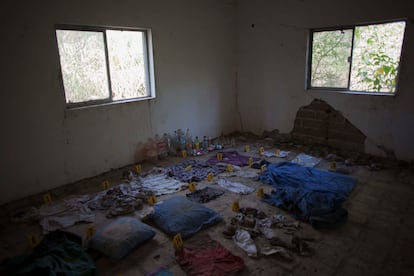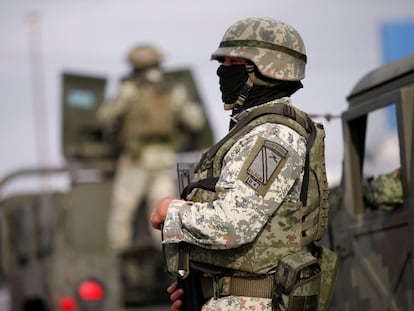Tamaulipas violence raises concerns in Mexico and the United States
The border state, where four U.S. citizens were kidnapped in early March, has the highest number of military shootings of civilians and disappeared persons in relation to the overall population

Recent events in the state of Tamaulipas have led both the Mexican and U.S. governments to look at the Gulf region in a way they have not done in years. The massacre of five young men in Nuevo Laredo in late February by security forces and the kidnapping of four U.S. citizens in Matamoros in early March have placed the border state in the spotlight. However, both events are part of the normality that has prevailed in the area in recent years.
Tamaulipas is one of the Mexican regions with the highest rate of disappearances, in general terms and by population. Prey to corruption and the links between criminal groups and the political and security apparatus, the state has suffered brutal peaks of violence due to disputes between organized crime organizations — first between the Gulf Cartel and Los Zetas and then between splinter factions of both groups, all with an eye on the border and smuggling. The armed forces also add to the equation, particularly the army, which serves as the de facto police force in the region. Between 2007 and 2022, the military has been involved in as many confrontations with alleged aggressors in Tamaulipas — 45% — as in the rest of Mexico’s states combined.
Disappearances have been a constant in Mexico since the end of 2006, when the federal government declared war on organized crime. In few places has this situation been felt as keenly as in Tamaulipas, where 11,680 people have been reported missing, according to the Interior Ministry. To date, the remains of only 527 have been found. With a population of 3.5 million, the rate of disappearances per 100,000 inhabitants in the state is among the highest in the country. The true scale is impossible to gauge, given the number of missing persons that are not included in the official count. Last year, the figure exceeded 100,000 nationwide.

With 17 border crossing points into the United States, Tamaulipas is also home to an enormous number of mass graves, where criminals dispose of bodies to hamper the work of the authorities. One was discovered a year and a half ago in Nuevo Laredo, from which forensic experts have barely been able to recover a few hundred pieces of bone. Authorities have been removing remains from another in La Bartolina, in Matamoros, near the location where investigators found the kidnapped Americans a week and a half ago, for more than five years.
The scale of violence in Tamaulipas is due in part to its geographic location and the number of crossing points into the U.S. The state is a lucrative place for the cartels and their institutional support networks. What in Matamoros, Reynosa, Nuevo Laredo or any of the small border towns is worth $20 multiplies in value a few hundred meters to the north, be it drugs or migrants. Organized crime is embedded in the region and clashes with security forces have been frequent over the past few years, particularly with the army, which has replaced the federal police along the border. Nowhere else in Mexico has the military been involved in more shootouts with suspected criminals than in Tamaulipas. The frequency of these confrontations masks a chain of errors, at best, and negligence and criminal activity, at worst.
The history is well known: in December 2006, the newly elected government of Felipe Calderón devised a strategy to combat organized crime, which consisted of sending troops into the streets, a plan that his successors have inherited. Over the years, the idea that Calderón’s policy stirred up a hornet’s nest, which in turn sharpened the skills of the cartels, has taken hold. On the other side of the coin, the military has faced continuous accusations of torture, forced disappearances and murder. The Nuevo Laredo case is the latest example of this. The attack by a military convoy on a group of unarmed young men, who were heading to a club for a night out, has once again called into question the security strategy maintained by three consecutive administrations, all of which to a lesser or greater degree have witnessed similar incidents, with military personnel opening fire without prior aggression.

Between January 2007 and the end of 2022, there were 5,229 clashes between military personnel and civilians in Mexico, according to data from the Secretariat of National Defense and compiled, ordered, and interpreted by Samuel Storr, a researcher at the Ibero-American University in Mexico City. Of those 5,229 confrontations, 2,494 occurred in Tamaulipas, mostly in the border cities of Matamoros, Reynosa and Nuevo Laredo.
However, cases like the five young men massacred in February do not appear among these statistics. Or at least they shouldn’t, since they never fired a shot. In a city like Nuevo Laredo, the attitude of the military who opened fire on the five unarmed victims can be explained by previous events. And that raises other questions that are difficult to answer. How can it be determined if, among the 2,494 incidents recorded in Tamaulipas in recent years, there are more cases like the one in Nuevo Laredo?
Storr points to the lethality index, a tool that helps flag incidents of this type for potential irregularities. The index measures the ratio of civilian injuries to civilian deaths in confrontations with security forces. Experts who developed the idea suggest that the normal ratio is one to one: one dead, one wounded, then two and two, and so on. As the number of dead exceeds the number of wounded, suspicions increase.

“Something is happening in Tamaulipas that hardly occurs in the rest of the country,” Storr explains. “Of the 2,494 clashes recorded in the state, far more than in any other, in 384 there were more than three civilians killed. And of those, in 335 cases there were no injuries and no arrests.” This does not mean that in those 335 cases there were illegal killings, but the possibility cannot be ruled out. The lack of capacity of the prosecutors’ offices, at both state and federal level, prevents thorough investigations from being carried out. Only when a case reaches the national press does the federal government intervene. Even then justice is not assured, but it is at least a start.
The data shows this trend is accelerating under Mexican President Andrés Manuel López Obrador. During the current administration, the number of incidents with more than three civilian deaths and no detainees or wounded has increased, representing a higher percentage than during the presidencies of his two predecessors, Enrique Peña Nieto and Calderón. From December 2018 to December 2022, Mexico recorded 85 confrontations that ended with more than three civilian deaths and no injuries or detainees. Of those, 62 occurred in Tamaulipas, 73% of the total. In the Peña Nieto years, the percentage dropped to 59% and during Calderón’s time in office the figure was 45%. In addition, under the current administration, the lethality rate of the army in Tamaulipas is over nine, more than double the national average.
Sign up for our weekly newsletter to get more English-language news coverage from EL PAÍS USA Edition
Tu suscripción se está usando en otro dispositivo
¿Quieres añadir otro usuario a tu suscripción?
Si continúas leyendo en este dispositivo, no se podrá leer en el otro.
FlechaTu suscripción se está usando en otro dispositivo y solo puedes acceder a EL PAÍS desde un dispositivo a la vez.
Si quieres compartir tu cuenta, cambia tu suscripción a la modalidad Premium, así podrás añadir otro usuario. Cada uno accederá con su propia cuenta de email, lo que os permitirá personalizar vuestra experiencia en EL PAÍS.
¿Tienes una suscripción de empresa? Accede aquí para contratar más cuentas.
En el caso de no saber quién está usando tu cuenta, te recomendamos cambiar tu contraseña aquí.
Si decides continuar compartiendo tu cuenta, este mensaje se mostrará en tu dispositivo y en el de la otra persona que está usando tu cuenta de forma indefinida, afectando a tu experiencia de lectura. Puedes consultar aquí los términos y condiciones de la suscripción digital.
More information
Archived In
Últimas noticias
The new victims of the Republican war on Obamacare: Millions hit by soaring health insurance premiums
A country divided on migrant rights: Some US states expand protections while others restrict them
Venezuela authorizes the release of another 87 political prisoners
There is as much life left to discover on planet Earth as that which is already known
Most viewed
- David King, chemist: ‘There are scientists studying how to cool the planet; nobody should stop these experiments from happening’
- Reinhard Genzel, Nobel laureate in physics: ‘One-minute videos will never give you the truth’
- Oona Chaplin: ‘I told James Cameron that I was living in a treehouse and starting a permaculture project with a friend’
- Sinaloa Cartel war is taking its toll on Los Chapitos
- The Interoceanic Train, the Mexican alternative to the Panama Canal











































